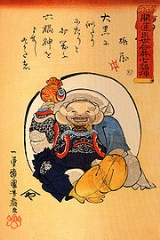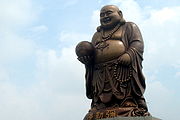
Hotei
Encyclopedia

Japanese language
is a language spoken by over 130 million people in Japan and in Japanese emigrant communities. It is a member of the Japonic language family, which has a number of proposed relationships with other languages, none of which has gained wide acceptance among historical linguists .Japanese is an...
, Bố Đại in Vietnamese
Vietnamese language
Vietnamese is the national and official language of Vietnam. It is the mother tongue of 86% of Vietnam's population, and of about three million overseas Vietnamese. It is also spoken as a second language by many ethnic minorities of Vietnam...
, is a Chinese folkloric
Chinese mythology
Chinese mythology is a collection of cultural history, folktales, and religions that have been passed down in oral or written tradition. These include creation myths and legends and myths concerning the founding of Chinese culture and the Chinese state...
deity. His name means "Cloth Sack," and comes from the bag that he is conventionally depicted as carrying. He is usually identified with (or as an incarnation of) Maitreya Buddha, so much so that the Budai image is one of the main forms in which Maitreya Buddha is depicted in East Asia. He is almost always shown smiling or laughing, hence his nickname in Chinese, the Laughing Buddha .
The Description
Budai is traditionally depicted as a fat bald man wearing a robe and wearing or otherwise carrying prayer beads. He carries his few possessions in a cloth sack, being poor but content. He is often depicted entertaining or being followed by adoring children. His figure appears throughout Chinese culture as a representation of contentment. His image graces many temples, restaurants, amulets, and businesses.The History
According to Chinese history, Budai was an eccentric Chán monk who lived in China during the Later Liang DynastyLater Liang Dynasty
The Later Liang was one of the Five Dynasties during the Five Dynasties and Ten Kingdoms Period in China. It was founded by Zhu Wen, posthumously known as Taizu of Later Liang, after he forced the last emperor of the Tang dynasty to abdicate in his favour...
(907–923 CE). He was a native of Fenghua
Fenghua
Fenghua is a county-level city in the north of Zhejiang province, China. It is under the jurisdiction of Ningbo prefecture-level city. The city and its administrative hinterlands has a population of over 480,000....
, and his Buddhist name was Qieci . He was considered a man of good and loving character.
The term buddha means "one who is awake", connoting one who has awakened into enlightenment. Over the history of Buddhism, there have been several notable figures who would come to be remembered as, and referred to as, buddhas. Later followers of the Chan school would come to teach that all beings possess Buddha nature within them, and are already enlightened, but have yet to realize it. This teaching would continue into Zen
Zen
Zen is a school of Mahāyāna Buddhism founded by the Buddhist monk Bodhidharma. The word Zen is from the Japanese pronunciation of the Chinese word Chán , which in turn is derived from the Sanskrit word dhyāna, which can be approximately translated as "meditation" or "meditative state."Zen...
.
Amongst those new to Buddhism, or otherwise unfamiliar with its history, Budai is often conflated with (or simply replaces) the historical Buddha, Siddhartha Gautama, in spite of the distinct visual differences in how each has been depicted. In India, Nepal, and throughout southeast Asia, Gautama (who lived during the 6th c. BCE) is commonly depicted as being tall and slender in appearance. In contrast, in China and those areas to which Chinese cultural influence spread, the depiction of Budai (who lived during the 10th c. CE) is consistently short and rotund. Both depictions are the idealized results of the religious, cultural and folkloric traditions which evolved in the centuries after their respective deaths.
Folklore
Budai in folklore is admired for his happiness, plenitude, and wisdom of contentment. One belief popular in folklore maintains that rubbing his belly brings wealth, good luck, and prosperity.In Japan, Hotei persists in folklore as one of the Seven Lucky Gods
Seven Lucky Gods
The , commonly referred to in English as the Seven Lucky Gods, refer to the seven gods of good fortune in Japanese mythology and folklore. They are often the subject of netsuke carvings and other representations.Each has a traditional attribute:...
(Shichi Fukujin) of Taoism
Taoism
Taoism refers to a philosophical or religious tradition in which the basic concept is to establish harmony with the Tao , which is the mechanism of everything that exists...
.
Buddhism
Some Buddhist traditions consider him a Buddha or a bodhisattvaBodhisattva
In Buddhism, a bodhisattva is either an enlightened existence or an enlightenment-being or, given the variant Sanskrit spelling satva rather than sattva, "heroic-minded one for enlightenment ." The Pali term has sometimes been translated as "wisdom-being," although in modern publications, and...
, often identifying him with Maitreya
Maitreya
Maitreya , Metteyya , or Jampa , is foretold as a future Buddha of this world in Buddhist eschatology. In some Buddhist literature, such as the Amitabha Sutra and the Lotus Sutra, he or she is referred to as Ajita Bodhisattva.Maitreya is a bodhisattva who in the Buddhist tradition is to appear on...
(the future Buddha).
His identification with the Maitreya Bodhisattva is attributed to a Buddhist hymn he uttered before his death:
- 彌勒真彌勒,化身千百億,時時示時人,時人自不識
-
- Maitreya, the true Maitreya
- has billions of incarnations.
- Often he is shown to people at the time;
- other times they do not recognize him.
Zen Buddhism
The primary story that concerns Budai in ZenZen
Zen is a school of Mahāyāna Buddhism founded by the Buddhist monk Bodhidharma. The word Zen is from the Japanese pronunciation of the Chinese word Chán , which in turn is derived from the Sanskrit word dhyāna, which can be approximately translated as "meditation" or "meditative state."Zen...
(Chán) is a short kōan. In it, Budai is said to travel giving candy to poor children, only asking a penny from Zen monks or lay practitioners he meets. One day a monk walks up to him and asks, "What is the meaning of Zen?" Budai drops his bag. "How does one realize Zen?" he continued. Budai then took up his bag and continued on his way.
I Kuan Tao
Statues of Budai form a central part of I Kuan Tao shrines, where he is usually referred to by the Sanskrit name MaitreyaMaitreya
Maitreya , Metteyya , or Jampa , is foretold as a future Buddha of this world in Buddhist eschatology. In some Buddhist literature, such as the Amitabha Sutra and the Lotus Sutra, he or she is referred to as Ajita Bodhisattva.Maitreya is a bodhisattva who in the Buddhist tradition is to appear on...
. According to I Kuan Tao, he represents many teachings, including contentment, generosity, wisdom and open kindheartedness. He is predicted to succeed Gautama Buddha
Gautama Buddha
Siddhārtha Gautama was a spiritual teacher from the Indian subcontinent, on whose teachings Buddhism was founded. In most Buddhist traditions, he is regarded as the Supreme Buddha Siddhārtha Gautama (Sanskrit: सिद्धार्थ गौतम; Pali: Siddhattha Gotama) was a spiritual teacher from the Indian...
as the next Buddha, and helps people realize the essence within, which connects with all beings.
Angida Arhat
Angida was one of the original eighteen Arhats of Buddhism. According to legend, Angida was a talented Indian snake catcher whose aim was to catch venomous snakes to prevent them from biting passers-by. Angida would also remove the snake's venomous fangs and release them. Due to his kindness, he was able to attain bodhiBodhi
Bodhi is both a Pāli and Sanskrit word traditionally translated into English with the word "enlightenment", but which means awakened. In Buddhism it is the knowledge possessed by a Buddha into the nature of things...
.
In Chinese art, Angida is sometimes portrayed as Budai, being rotund, laughing, and carrying a bag. In Nepali, he is also called hasne buddha ("laughing Buddha").
Phra Sangkajai/ Phra Sangkachai
In ThailandThailand
Thailand , officially the Kingdom of Thailand , formerly known as Siam , is a country located at the centre of the Indochina peninsula and Southeast Asia. It is bordered to the north by Burma and Laos, to the east by Laos and Cambodia, to the south by the Gulf of Thailand and Malaysia, and to the...
, Budai is sometimes confused with another similar monk widely respected in Thailand, Phra Sangkajai or Sangkachai . Phra Sangkajai, a Thai spelling of Mahakaccayana
Katyayana (Buddhist)
Katyayana was a disciple of Gautama Buddha.Katyayana, also known as Kaccana , Mahakatyayana, Mahakaccana and in Japanese as Kasennen, is one of the "Ten Disciples of the Buddha". [ Mahakashyapa, 2) Ananda, 3) Shariputra, 4) Subhuti, 5) Purna, 6) Mahamaudgalyayana, 7) Maha Katyayana, 8) Aniruddha,...
thera , was a Buddhist Arhat (in Sanskrit
Sanskrit
Sanskrit , is a historical Indo-Aryan language and the primary liturgical language of Hinduism, Jainism and Buddhism.Buddhism: besides Pali, see Buddhist Hybrid Sanskrit Today, it is listed as one of the 22 scheduled languages of India and is an official language of the state of Uttarakhand...
) or Arahant (in Pali
Páli
- External links :* *...
) during the time of the Lord Buddha
Gautama Buddha
Siddhārtha Gautama was a spiritual teacher from the Indian subcontinent, on whose teachings Buddhism was founded. In most Buddhist traditions, he is regarded as the Supreme Buddha Siddhārtha Gautama (Sanskrit: सिद्धार्थ गौतम; Pali: Siddhattha Gotama) was a spiritual teacher from the Indian...
. Lord Buddha praised Phra Sangkadchai for his excellence in explaining sophisticated dharma
Dharma
Dharma means Law or Natural Law and is a concept of central importance in Indian philosophy and religion. In the context of Hinduism, it refers to one's personal obligations, calling and duties, and a Hindu's dharma is affected by the person's age, caste, class, occupation, and gender...
(or dhamma) in an easily and correctly understandable manner. Phra Sangkajai also composed the Madhupinadika Sutra.
One tale relates that he was so handsome that once even a man wanted him for a wife. To avoid a similar situation, Phra Sangkadchai decided to transform himself into a fat monk. Another tale says he was so attractive that angels and men often compared him with the Buddha
Gautama Buddha
Siddhārtha Gautama was a spiritual teacher from the Indian subcontinent, on whose teachings Buddhism was founded. In most Buddhist traditions, he is regarded as the Supreme Buddha Siddhārtha Gautama (Sanskrit: सिद्धार्थ गौतम; Pali: Siddhattha Gotama) was a spiritual teacher from the Indian...
. He considered this inappropriate, so disguised himself in an unpleasantly fat body.

- Phra Sangkajai has a trace of hair on his head (looking similar to the Buddha's) while Budai is clearly bald.
- Phra Sangkajai wears the robes in Theravadin Buddhist fashion with the robes folded across one shoulder, leaving the other uncovered. Budai wears the robes in Chinese style, covering both arms but leaving the front part of the upper body uncovered.

